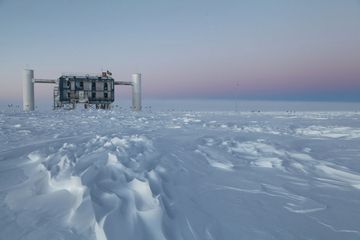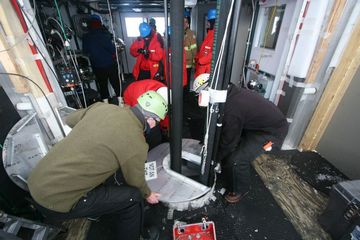Jul 14, 2018
Going Low ... and Finding Neutrinos
Offered by David Apollo

The IceCube detector, buried below the ice, South Pole
This is one of those times.
Neutrinos. Neutrinos typically pass through normal matter unimpeded and undetected.
For those who care - neutrinos are uncharged leptons, and are thus subject only to gravitation and the weak interaction.
A neutrino's rest mass is so small that it was long thought to be zero.
We can detect them, indirectly when made in the lab, experimentally. But can we detect neutrinos that are generated in nature? Are neutrinos something that occurs naturally, or are they only a result of experiments performed by humans? Are neutrinos natural?
NOvA: Exploring Neutrino Mysteries (5:51)
While it is stretching nomenclature quite a bit, in the abstract, "Can we find 'organic' neutrinos?" Are they naturally occuring?
And, why might we care?
Enter the IceCube Neutrino Observatory. IceCube is a neutrino observatory constructed at the South Pole. Its thousands of sensors are distributed over a cubic kilometre of volume ranging from 1.5 - 2.5 kilometers below the surface within the Antarctic ice. Detection of neutrinos is still indirect (it has to be, direct detection is not possible.) And, it is best able to discern a credible indirect detection of neutrinos that have passed through the earth from the North Pole. !!
Probably the most extreme example of an Asymmetry of the Filters issue (i.e. cannot perceive what you are not built to be) ever attempted to be overcome.
Other neutrino detectors:
- The NOvA Far Detector - The Fermi National Accelerator Laboratory sends a beam of neutrinos to a 14,000-ton detector in Ash River, Minnesota. The particles complete the 500-mile interstate trip in less than three milliseconds, straight through the Earth without a tunnel.
Check out the detector in action here.
The following was reproduced from
Scientists Track Neutrinos Through Ice to Their Source in the Cosmos
The Wall Street Journal; July 12, 2018;
Robert Lee Hotz
Scientists Track Neutrinos Through Ice to Their Source in the Cosmos
By Robert Lee Hotz
These ghostly particles may reveal a hidden universe of strange materials and energy
Astronomers for the first time traced a burst of powerful cosmic particles called neutrinos to a black hole firing like a ray gun aimed at Earth, by using an unusual observatory buried in a billion tons of ice under the South Pole.
The international research team said it believes the discovery, announced Thursday at the National Science Foundation in Washington, D.C., may pinpoint the first known source of high-energy cosmic rays, putting to rest a mystery that has bedeviled astrophysicists for decades.
RelatedUnaffected by normal matter, radiation or gravity, ghostly neutrinos are the most abundant, energetic and least-understood particles in the universe, hurtling through space rarely interacting with ordinary stuff. Always traveling in an inflexible straight line, though, they lead unerringly back to the point where they were created - a likely source of the high-energy cosmic rays that shower Earth, the scientists said.
Scientists are eager to learn all they can about cosmic rays because they produce cascades of subatomic particles, X-rays and other electromagnetic radiation when they hit Earth's atmosphere.
Ice-Fishing for Neutrinos"This is one of the oldest problems in astronomy," said Francis Halzen, a physicist at the University of Wisconsin - Madison and lead scientist for the IceCube Neutrino Observatory in Antarctica. "By identifying the source of these neutrinos, we identified a source of cosmic rays."
Under the ice of the South Pole, researchers constructed a $274 million
observatory to map the universe using neutrinos. These unusual
subatomic particles are almost impossible to detect because they usually
are unaffected by normal matter, radiation or gravity.
IceCube lab
In-ice sensor network
Engineers used hot-water drills
to melt 86 holes, a mile deep or
more, into the ice. There they
lowered 5,160 electric-optical
sensors into the holes, then
allowed them to freeze in place.
Deep core
The sensors detect the flare from
the rare collision of a neutrino and
normal atom as the particle speeds
through the array and relay the
signal to the surface, accurate to
within five-billionths of a second.
Bedrock
Neutrino astronomy
By plotting the direction of a neutrino through the ice, researchers expect to reconstruct
its route back across the universe to its origin in a supernova or other cosmic cataclysm.
On rare occasions, a neutrino
will come in contact with a
proton or neutron.
NeutrinoWhen the two collide,
a particle known as a
muon emerges.
MuonMuons radiate blue light as
they move through ice on the
same path as the neutrino.
Muon
Proton Collision Blue light
Source: IceCube Project, University of Wisconsin-Madison
By their reckoning, one of the most luminous objects in the known universe hurls these high-energy neutrinos toward Earth - a galaxy called a blazar located in the constellation Orion about four billion light years away. This cloud of stars is being devoured by a black hole - a maw with the mass of a million suns compressed into a space no larger than our own solar system, said physicist Kam-Biu Luk at the University of California, Berkeley, who wasn't part of the project.
In its astrophysical agony, the blazar spits a jet of charged cosmic ray particles coupled with neutrinos a million times more energetic than any particle accelerator on Earth could produce, but no one is sure how or why. "There is something complicated going on inside this source," said astrophysicist Naoko Kurahashi Neilson at Drexel University in Philadelphia, who analyzed the neutrino data. "This observation only deepens the mystery."
One of the neutrino-catching probes at the IceCube Neutrino
Observatory. They had to be quickly lowered into the ice before
it completely froze around them.
Photo: Jim Haugen/IceCube/National Science Foundation
The find caps almost 20 years of work by the IceCube Collaboration, comprising more than 300 astrophysicists and astronomers at 48 research centers in a dozen countries, led by scientists at the University of Wisconsin - Madison. Funded by the National Science Foundation, the $274 million Ice Cube Observatory at the U.S. Amundsen-Scott South Pole Station is the largest astronomy project ever undertaken on the isolated southernmost continent.
Their initial discovery was confirmed by astronomers at 20 observatories, including NASA's orbiting Fermi Gamma-ray Space Telescope. They spotted intense flares of gamma rays erupting at the same spot in space as the high-energy neutrinos. The astronomers and astrophysicists documented their work in a pair of research papers published in Science on Thursday.
Until now, astronomers had been able to identify sources of only the weakest neutrino particles, which trickle from the sun and a nearby supernova.
It takes a strange observatory to spot a particle that normally shies away from normal matter. In the hunt, scientists have erected detectors in a South Dakota cavern a mile underground, at the bottom of Lake Baikal in Siberia, under a mountain in Japan, and on the floor of the Mediterranean Sea.
But the largest is the IceCube, created from a cubic kilometer of the purest and most transparent ice in the world. Frozen in place are more than 5,000 basketball-size optical sensors designed to catch a trace of a passing neutrino on the rare occasion one of them interacts with the ice.
Researchers uncover a mile-deep bore hole for the IceCube
Neutrino Observatory at the South Pole.
Photo: Robert Lee Hotz/The Wall Street
Last Sept. 22, the IceCube detectors registered the eerie blue glow of light that signaled the passage of a single high-energy neutrino through the ice. In any given second, trillions of the high-energy neutrinos are passing by the sensors, but only about 10 a year trigger an alarm.
"We sent out a neutrino alert within a minute or two," said particle astrophysicist Dawn Williams at the University of Alabama in Tuscaloosa, who coordinates IceCube data analysis. "The telescopes were able to follow up on it and find compelling evidence that this blazar was associated with this high-energy neutrino."
The discovery heralds the next step in what scientists call multi-messenger astronomy, which probes the cosmos with telescopes working across different wavelengths and now with detectors of gravitational waves as well. The neutrinos, which penetrate matter, offer a way to explore a universe of material and energy hidden from ordinary light and the conventional electromagnetic spectrum, said physicist Olga Botner at Sweden's Uppsala University, a senior member of the project.
"This is the first real step in being able to utilize neutrinos as a tool to view the most extreme astrophysical processes in the universe," said IceCube physicist Darren Grant at the University of Alberta in Canada.
Write to Robert Lee Hotz at sciencejournal@wsj.com
Appeared in the July 13, 2018, print edition as 'Ghost Particle's Birthplace Found.'
Conserve the Liberty to be what you are, even if what you are is almost completely indetectable.
Thus endeth the Thought for the Week!!!
thought/20180713_thought_neutrinos_ghosts.html